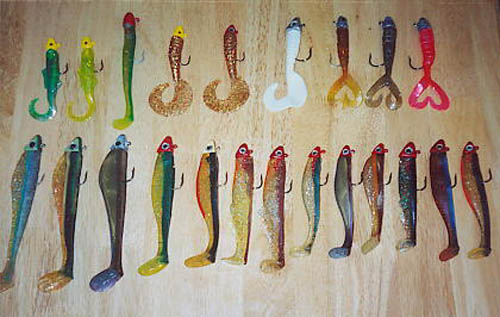
Fishing PlasticsFishing with plastic lures is probably the most common method of coastal saltwater fishing next to the use of live bait (or fresh dead). You can cast, drift or troll with plastic baits. *Scent enhancers or cut pieces of frozen/defrosted squid can be used for added attraction. They can be rigged Texas/Carolina Style with a hook and a separate sinker, or they can be fished with a lead head. The most common way to fish them is with a lead head. Lead heads come in various weight, hook sizes, colors and “details” (eyes, markings). The lead heads are usually sold separate from the plastic baits. You will usually have to rig them yourself. Set aside one plastic to practice rigging with. · Kelp Beds: A good place to check for fish activity is in the kelp beds. Bass, rockfish, rays, sharks, croakers and various other game species can regularly be sought out. Plastic lures are ideal for these fishing grounds. Casting along the kelp line (outside edge of the kelp bed) and locating holes (pot holes) in the kelp to drop plastics through; drop the plastic down paying close attention to any bites that might occur as the plastic is sinking. Be prepared to set the hook if you feel your plastic take a hit on the way down. To set the hook, swing the rod tip up. If you miss on the first attempt, put the reel back in free spool (or open the bale) and allow the plastic to sink again. Sometimes the same fish that hit your lure the first time will come back to hit it a 2nd and even possibly a 3rd time. If you do get bit on the retrieve you'll want to maintain a steady wind (wind through the bites/nibbles). There are a few methods for swimming plastics when using the vertical approach. One is the “Yo Yo” method. Winding the lure up a little bit and then allowing it to fall back down. This action is good for covering the entire water column. Fish will “pack” at various depths depending on water temperature, clarity and where the bait seems to be holding. Another method is "jigging". Jigging involves raising the rod tip slowly but deliberately up, and then bringing it back down to horizontal. The lure darts upward from raising the rod tip up. The lure's natural flutter action kicks in as it decends. Various freshwater bass techniques for causing subtle and erratic movements that may be utilized as well. Be prepared for fish to be following bait to the surface. Sometimes a strong surface bite will occur. Watch for the "boils" in the water and cast your plastic over them. The term "boils" refers to the action the water makes when a fish hits the surface. Boils usually occur when the larger fish are chasing the smaller bait fish. Wind your bait through the area the boils were showing. · Kelp Stringers: Some of the best fishing can be found in this fish oasis. Cast along side or drift past them with the plastic in tow. Again, it all depends on what depth the fish are holding at. Though I usually like to put the plastic on the bottom or very close to it before starting the retrieve. There are a variety of actions you can attempt in various combinations to entice the fish. It’s recommended that most the action you initiate be done with the use of your reel. The winding action produces a nice swimming motion on plastic baits. Alternate various retrieve speeds and work the various depths of the water column. · Structure: Locating structure can be a good thing when targeting game fish with plastics. Cast to a boiler rock or drift your plastic along the bottom of a reef. "Bounce it" off the bottom, jig it, cast and retrieve; fish can be very aggressive in these rocky and turbulent habitats. Water movement can be extremely swift around these areas. When the fish are enticed they may respond aggressively in order to take advantage of the opportunity. -Visible Rock Formations and Boiler Rocks -Reefs (visible and non visible) -Structure only visible by sonar (reefs, rocks, corral) Choosing Your PlasticI don’t think there is an exact science when it comes to choosing the color or pattern of you plastic. What works one day may not work the next. Though there are two things to consider right off the bat that may help in a successful selection. Try matching your plastic to what the fish are currently feeding on. Does the targeted game fish have a known preference for a specific species of bait? What bait is abundant in the area? The next thing to consider is the color or shade of water. With that said, darker days (or time of day) should be fished with darker colors and lighter days should be fished with lighter colors. From there you will have this to consider: Pattern: sparkles, no sparkles, molding details, lines, etc; Shape, Type, Model: swim baits, scampi, grubs, etc; Color: matching to local baitfish and/or water color and lighting
Size: matching local baitfish, size of fish being targeted (bigger fish, bigger lure) Lead Head Size/Weight: current (stronger current= heavier weight/lead head), cast distance and target depth should all be considered. *Adding strips or whole squid to your lure can adversely affect the swimming action. We advise cutting even, thin strips in order to maintain a steady fluttering effect and as well to limit the amount of action that may be hindered by the additional weight. <back |